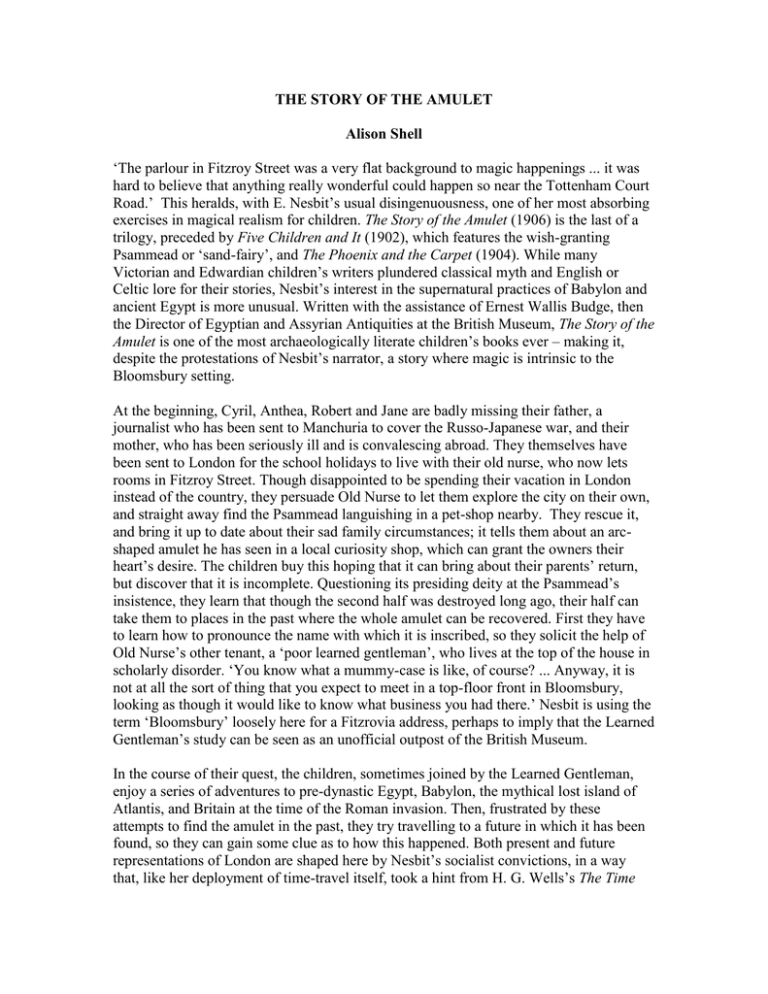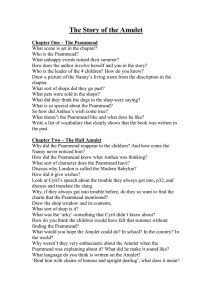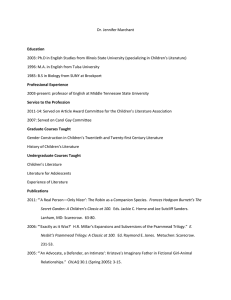THE STORY OF THE AMULET Alison Shell
advertisement

THE STORY OF THE AMULET Alison Shell ‘The parlour in Fitzroy Street was a very flat background to magic happenings ... it was hard to believe that anything really wonderful could happen so near the Tottenham Court Road.’ This heralds, with E. Nesbit’s usual disingenuousness, one of her most absorbing exercises in magical realism for children. The Story of the Amulet (1906) is the last of a trilogy, preceded by Five Children and It (1902), which features the wish-granting Psammead or ‘sand-fairy’, and The Phoenix and the Carpet (1904). While many Victorian and Edwardian children’s writers plundered classical myth and English or Celtic lore for their stories, Nesbit’s interest in the supernatural practices of Babylon and ancient Egypt is more unusual. Written with the assistance of Ernest Wallis Budge, then the Director of Egyptian and Assyrian Antiquities at the British Museum, The Story of the Amulet is one of the most archaeologically literate children’s books ever – making it, despite the protestations of Nesbit’s narrator, a story where magic is intrinsic to the Bloomsbury setting. At the beginning, Cyril, Anthea, Robert and Jane are badly missing their father, a journalist who has been sent to Manchuria to cover the Russo-Japanese war, and their mother, who has been seriously ill and is convalescing abroad. They themselves have been sent to London for the school holidays to live with their old nurse, who now lets rooms in Fitzroy Street. Though disappointed to be spending their vacation in London instead of the country, they persuade Old Nurse to let them explore the city on their own, and straight away find the Psammead languishing in a pet-shop nearby. They rescue it, and bring it up to date about their sad family circumstances; it tells them about an arcshaped amulet he has seen in a local curiosity shop, which can grant the owners their heart’s desire. The children buy this hoping that it can bring about their parents’ return, but discover that it is incomplete. Questioning its presiding deity at the Psammead’s insistence, they learn that though the second half was destroyed long ago, their half can take them to places in the past where the whole amulet can be recovered. First they have to learn how to pronounce the name with which it is inscribed, so they solicit the help of Old Nurse’s other tenant, a ‘poor learned gentleman’, who lives at the top of the house in scholarly disorder. ‘You know what a mummy-case is like, of course? ... Anyway, it is not at all the sort of thing that you expect to meet in a top-floor front in Bloomsbury, looking as though it would like to know what business you had there.’ Nesbit is using the term ‘Bloomsbury’ loosely here for a Fitzrovia address, perhaps to imply that the Learned Gentleman’s study can be seen as an unofficial outpost of the British Museum. In the course of their quest, the children, sometimes joined by the Learned Gentleman, enjoy a series of adventures to pre-dynastic Egypt, Babylon, the mythical lost island of Atlantis, and Britain at the time of the Roman invasion. Then, frustrated by these attempts to find the amulet in the past, they try travelling to a future in which it has been found, so they can gain some clue as to how this happened. Both present and future representations of London are shaped here by Nesbit’s socialist convictions, in a way that, like her deployment of time-travel itself, took a hint from H. G. Wells’s The Time Machine (1895). But while Wells’ novel projects the failings of capitalism forward in its depiction of downtrodden workers and an infantilised leisure class – the Morlocks and Eloi – Nesbit’s idea of the future owes more to one of English Socialism’s founding texts, William Morris’s News from Nowhere (1890). The fact that Morris’s novel is partly set in the British Museum may also lie behind Nesbit’s choice of it as a setting to point up contrasts between past, present and future. After seeing the complete amulet on display there, the children emerge into a utopian Bloomsbury where even the weather is perfect. ‘As they came through the doors of the Museum they blinked at the sudden glory of sunlight and blue sky. The houses opposite the Museum were gone. Instead there was a big garden, with trees and flowers and smooth green lawns, ... the pigeons that swept about among the branches ... were not black and tumbled as the Museum birds are now, but bright and clean and sleek as birds of new silver.’ A woman they meet is curious to see what her city was like in the past, but when taken through the amulet’s magic arch, she is horrified by what she experiences. The sky was grey, the street was foggy, a dismal organ-grinder was standing opposite the door, a beggar and a man who sold matches were quarrelling at the edge of the pavement on whose greasy black surface people hurried along, hastening to get to the shelter of their houses. ‘Oh, look at their faces, their horrible faces!’ she cried. ‘What’s the matter with them all?’ ‘They’re poor people, that’s all,’ said Robert. ‘But it’s not all! They’re ill, they’re unhappy, they’re wicked! Oh, do stop it, there’s dear children.’ Elsewhere, Nesbit is keener to play up the comedy in mismatches between London’s past and present. Arriving in London as a result of a wish unwillingly granted by the Psammead, the Queen of Babylon sets the city in turmoil by demanding, again of the Psammead, that its inhabitants should be dressed like Babylonians, and that the undernourished ‘slaves’ or working classes should have their hands filled with their favourite foodstuffs – another leap of fancy that stems from Nesbit’s socialism. When the children take the Queen to the British Museum as a means of keeping her entertained, she causes further trouble. In Robert’s words, she ‘kicked up the most frightful shine in there. Said those necklaces and earrings and things in the glass cases were all hers ... tried to break the glass.’ Her outrage – perhaps parodying the debate surrounding the British Museum’s Elgin Marbles, ongoing from the early 1800s – culminates in the demand that all the Babylonian artefacts in the British Museum should come out into its courtyard. The first to arrive is an enormous stone bull, followed by ‘more stone images, by great slabs of carved stone, bricks, helmets, tools, weapons, fetters, wine-jars, bowls, bottles, vases, jugs, saucers, [and] seals’. A passing journalist, seeing the Queen at the centre of it all, asks Robert: ‘ “Theosophy, I suppose. Is she Mrs Besant?” “Yes”, said Robert recklessly.’ As well as being one of the early twentieth century’s most notorious occultists, Annie Besant was also a socialist, and Nesbit’s in-joke points to the close relationship at this date between esoteric belief and political radicalism. Theosophy, a syncretic mix of spiritualism, transcendentalism and various oriental mystical traditions, drew on the past but emphasized human perfectibility in a way that many left-leaning individuals found attractive. The occult Order of the Golden Dawn, of which Nesbit was a member, played on a similar urge to go back to the future. Even on a materialist level, The Story of the Amulet explores the close relationship between socialism and the power of wishing. In the book’s most explicit tribute to Wells, Nesbit describes his contribution to human happiness as ‘[seeing] that what you ought to do is to find out what you want and then try to get it.’ But The Story of the Amulet concludes with the main characters finding their personal rather than their political heart’s desire. An Egyptian priest, Rekh-mara, who possessed the children’s half of the Amulet in a former time, magically appears in London and helps them lay hands on the complete Amulet. Wishing to remain in the present day as ‘the great knower of all that has been’, Rekh-mara, in an ending that would be extraordinary even in a children’s book of today, goes through a same-sex mystical marriage with the Learned Gentleman and is subsumed into his body: this fulfils his desire to attain ‘a learning greater and deeper than that of any man of my land and time’, while the Learned Gentleman is left with an intuitive appreciation of the ancient world that is to bring him wealth and scholarly fame. The children too are granted their heart’s desire when their parents return unexpectedly; they impulsively present the Learned Gentleman with the Amulet, the object of his own wishes, and his grateful soliloquy ends the book. ‘What a treasure! The dear children! It must be their affection that has given me these luminous aperçus. I seem to see so many things now – things I never saw before!’ Both the arc of the Amulet and the portals of the British Museum are used by Nesbit as metaphors for the archaeologist’s travel between present and past, and throughout her novel, that past is seen as a place to acquire spiritual power, secure affective bonds and energise the future. * * * * * Quotations from E. Nesbit, The Story of the Amulet (London: Puffin, 1996). Further reading: Briggs, Julia, A Woman of Passion: The Life of E. Nesbit, 1858–1924 (London: Penguin, 1989) Budge, E. A. Wallis, Amulets and Magic (London: Kegan Paul, 2001) James, Raymond E., ed, E. Nesbit’s Psammead Trilogy: A Children’s Classic at 100 (Lanham, Maryland: Children’s Literature Association/Scarecrow Press, 2006) (Childrens’ Literature Association Centennial Series, 3) Prickett, Stephen, Victorian Fantasy (Hassocks: Harvester, 1979) Rose, Jonathan, The Edwardian Temperament, 1895–1919 (Athens: Ohio UP, 1986)




